The mid-cap growth style ranks seventh out of the twelve fund styles as detailed in my style roadmap. It gets my Neutral rating, which is based on aggregation of ratings of 10 ETFs and 367 mutual funds in the mid-cap growth style as of July 18, 2012.
Figure 1 ranks from best to worst the eight mid-cap growth ETFs that meet our liquidity standards and Figure 2 shows the five best and worst-rated mid-cap growth mutual funds. Not all mid-cap growth style ETFs and mutual funds are created the same. The number of holdings varies widely (from 17 to 458), which creates drastically different investment implications and ratings. The best ETFs and mutual funds allocate more value to Attractive-or-better-rated stocks than the worst, which allocate too much value to Neutral-or-worse-rated stocks.
To identify the best and avoid the worst ETFs and mutual funds within the mid-cap growth style, investors need a predictive rating based on (1) stocks ratings of the holdings and (2) the all-in expenses of each ETF and mutual fund. Investors need not rely on backward-looking ratings.
Investors should not buy any mid-cap growth ETFs or mutual funds because none get an Attractive-or-better rating. If you must have exposure to this style, you should buy a basket of Attractive-or-better rated stocks and avoid paying undeserved fund fees. Active management has a long history of not paying off.
Figure 1: ETFs with the Best & Worst Ratings – Top 5 (where available)
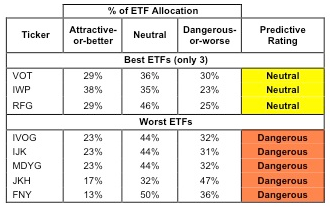
* Best ETFs exclude ETFs with less NAV’s less than 100 million.
Sources: New Constructs, LLC and company filings
PowerShares RAFI Fundamental Pur Mid Growth Portfolio (PXMG) and ProShares Ultra Russell MidCap Growth (UKW) are excluded from Figure 1 because their total net assets (TNA) are below $100 million and do not meet our liquidity standards.
Figure 2: Mutual Funds with the Best & Worst Ratings – Top 5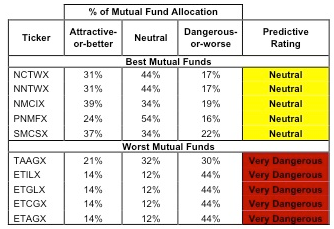
* Best mutual funds exclude funds with NAV’s less than 100 million.
Sources: New Constructs, LLC and company filings
Eight mutual funds are excluded from Figure 2 because their total net assets (TNA) are below $100 million and do not meet our liquidity standards.
Vanguard Mid-Cap Growth ETF (VOT) is my top-rated mid-cap growth ETF and Nicholas II, Inc: Class I Shares (NCTWX) is my top-rated mid-cap growth mutual fund. Both earn my Neutral rating.
First Trust Mid Cap Growth AlphaDEX Fund (FNY) earns my Dangerous rating and is my worst-rated mid-cap growth ETF. Mutual Fund Series Trust: Eventide Gilead Fund (ETAGX) earns my Very Dangerous rating and is my worst-rated mid-cap growth mutual fund.
Figure 3 shows that 367 out of the 1463 stocks (29% of the total net assets) held by mid-cap growth ETFs and mutual funds get an Attractive-or-better rating. This low allocation to investment worthy stocks is the reason no mid-cap growth ETFs or mutual funds are worth buying. None of the 367 mutual funds are justifying their total annual costs.
The takeaways are: mutual fund managers allocate too much capital to low-quality stocks and mid-cap growth ETFs offer exposure to poor quality stocks.
Figure 3: Mid-cap Growth Style Landscape For ETFs, Mutual Funds & Stocks 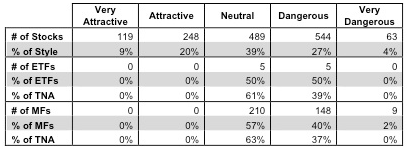
Sources: New Constructs, LLC and company filings
As detailed in “Cheap Funds Dupe Investors”, the fund industry offers many cheap funds but very few funds with high-quality stocks, or with what I call good portfolio management.
Investors should not buy any mid-cap growth ETFs and mutual funds. None of mid-cap growth ETFs or mutual funds allocate enough value to Attractive-or-better-rated stocks to earn an Attractive-or-better rating. Investors seeking exposure to mid-cap growth stocks are better off buying Attractive-or-better-rated mid-cap growth stocks.
Altera Corporation (ALTR) is one of my favorite stocks held by mid-cap growth ETFs and mutual funds and earns my Very Attractive rating. ALTR is a model for capital efficiency with a return on invested capital (ROIC) of 251% for fiscal year end 2011, which places the company in the 99th percentile of the Russell 3000. A high ROIC makes ALTR a good company, and it is also a great stock. ALTR”s current stock price (~$30.69) implies that profits (NOPAT) will permanently decrease by 20%. Strong economics coupled with low expectations make ALTR an excellent long candidate.
Digital Realty Trust, Inc. (DLR) is one of my least favorite stocks held by mid-cap growth ETFs and mutual funds and earns my Very Dangerous rating. DLR has misleading earnings, which means that its reported earnings are positive and rising while its economic earnings are negative and declining. Couple that with the fact that the company has failed to generate a ROIC in excess of its weighted average cost of capital (WACC) since 2004, and its clear that DLR does not have a profitable business model. In spite of poor past performance, the market believes DLR will turn things around. To justify its current stock price (~$80.31) the company must increase profits by 10.2% compounded annually for 36 years. Poor past performance and a high performance hurdle offer investors a poor risk/reward tradeoff.
Figures 4 and 5 show the rating landscape of all mid-cap growth ETFs and mutual funds.
Figure 4: Separating the Best ETFs From the Worst Funds 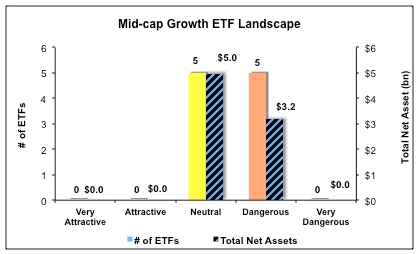
Sources: New Constructs, LLC and company filings
Figure 5: Separating the Best Mutual Funds From the Worst Funds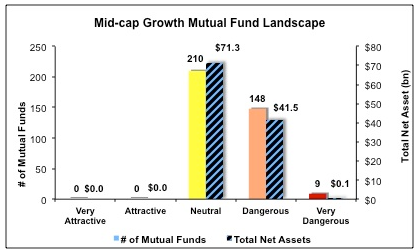
Sources: New Constructs, LLC and company filings
Disclosure: I receive no compensation to write about any specific stock, sector, style or theme.
- English (UK)
- English (India)
- English (Canada)
- English (Australia)
- English (South Africa)
- English (Philippines)
- English (Nigeria)
- Deutsch
- Español (España)
- Español (México)
- Français
- Italiano
- Nederlands
- Português (Portugal)
- Polski
- Português (Brasil)
- Русский
- Türkçe
- العربية
- Ελληνικά
- Svenska
- Suomi
- עברית
- 日本語
- 한국어
- 简体中文
- 繁體中文
- Bahasa Indonesia
- Bahasa Melayu
- ไทย
- Tiếng Việt
- हिंदी
Best And Worst ETFs (And Mutual Funds): Mid-Cap Growth
Published 07/20/2012, 09:35 AM
Updated 07/09/2023, 06:31 AM
Best And Worst ETFs (And Mutual Funds): Mid-Cap Growth
Latest comments
Loading next article…
Install Our App
Risk Disclosure: Trading in financial instruments and/or cryptocurrencies involves high risks including the risk of losing some, or all, of your investment amount, and may not be suitable for all investors. Prices of cryptocurrencies are extremely volatile and may be affected by external factors such as financial, regulatory or political events. Trading on margin increases the financial risks.
Before deciding to trade in financial instrument or cryptocurrencies you should be fully informed of the risks and costs associated with trading the financial markets, carefully consider your investment objectives, level of experience, and risk appetite, and seek professional advice where needed.
Fusion Media would like to remind you that the data contained in this website is not necessarily real-time nor accurate. The data and prices on the website are not necessarily provided by any market or exchange, but may be provided by market makers, and so prices may not be accurate and may differ from the actual price at any given market, meaning prices are indicative and not appropriate for trading purposes. Fusion Media and any provider of the data contained in this website will not accept liability for any loss or damage as a result of your trading, or your reliance on the information contained within this website.
It is prohibited to use, store, reproduce, display, modify, transmit or distribute the data contained in this website without the explicit prior written permission of Fusion Media and/or the data provider. All intellectual property rights are reserved by the providers and/or the exchange providing the data contained in this website.
Fusion Media may be compensated by the advertisers that appear on the website, based on your interaction with the advertisements or advertisers.
Before deciding to trade in financial instrument or cryptocurrencies you should be fully informed of the risks and costs associated with trading the financial markets, carefully consider your investment objectives, level of experience, and risk appetite, and seek professional advice where needed.
Fusion Media would like to remind you that the data contained in this website is not necessarily real-time nor accurate. The data and prices on the website are not necessarily provided by any market or exchange, but may be provided by market makers, and so prices may not be accurate and may differ from the actual price at any given market, meaning prices are indicative and not appropriate for trading purposes. Fusion Media and any provider of the data contained in this website will not accept liability for any loss or damage as a result of your trading, or your reliance on the information contained within this website.
It is prohibited to use, store, reproduce, display, modify, transmit or distribute the data contained in this website without the explicit prior written permission of Fusion Media and/or the data provider. All intellectual property rights are reserved by the providers and/or the exchange providing the data contained in this website.
Fusion Media may be compensated by the advertisers that appear on the website, based on your interaction with the advertisements or advertisers.
© 2007-2025 - Fusion Media Limited. All Rights Reserved.
